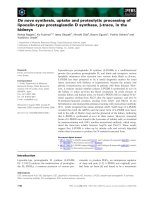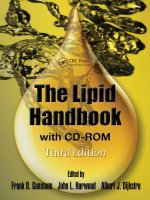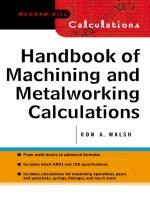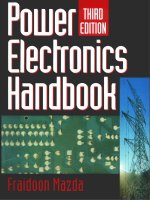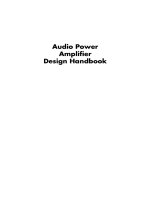mcgraw hill machining and metalworking handbook 3rd ed r walsh d cormier mcgraw hill 2006 ww 9 pptx
Bạn đang xem bản rút gọn của tài liệu. Xem và tải ngay bản đầy đủ của tài liệu tại đây (18.91 MB, 976 trang )
http://72.3.142.35/mghdxreader/jsp/FinalDisplay.jsp;jsessionid=a-OrD
1 of 1 10/30/2007 6:41 PM
Catalo
g
in
g
-in-Publication Data is on file with the Librar
y
of Con
g
ress
Walsh, Ronald A.
McGraw-Hill machining and metalworking handbook / Ronald A. Walsh.
and Denis R. Cormier—3rd ed.
p
. cm.
ISBN 0-07-145787-9
1. Machining—Handbooks, manuals, etc. 2. Metal-work—Handbooks,
manuals, etc. I. Cormier, Denis R. II. Title.
TJ1185.W35 2005
2005051055
Copyright © 2006, 1999, 1994 by The McGraw-Hill Companies, Inc.
All rights reserved. Printed in the United States of America. Except as permitted under the United States
Copyright Act of 1976, no part of this publication may be reproduced or distributed in any form or by any
means, or stored in a data base or retrieval system, without the prior written permission of the publisher.
1 2 3 4 5 6 7 8 9 0 DOC/DOC 0 1 0 9 8 7 6 5
ISBN 0-07-145787-9
The sponsoring editor for this book was Kenneth McCombs, the editing
s
upervisor was Caroline Levine, an
d
the production supervisor was
P
amela A. Pelton. The art director for the cover was Handel Low. It was set in
Century Schoolbook by Wayne A. Palmer of McGraw-Hill
P
rofessional’s Hightstown, N.J., composition unit.
P
rinted and bound by R. R. Donnelley & Sons Company.
McGraw-Hill books are available at special quantity discounts to use as premiums and sales promotions, or
for use in corporate training programs. For more information, please write to the Director of Special Sales,
McGraw-Hill, Professional Publishing, 2 Penn Plaza, New York, NY 10121-2298. Or contact your local
b
ookstore.
Information contained in this work has been obtained by The McGraw-Hill Companies, Inc. (“McGraw-Hill”)
from sources believed to be reliable. However, neither McGraw-Hill nor its authors guarantee the accuracy or
completeness of any information published herein, and neither McGraw-Hill nor its authors shall be
responsible for any errors, omissions, or damages arising out of use of this information. This work is
published with the understanding that McGraw-Hill and its authors are supplying information but are not
attempting to render engineering or other professional services. If such services are required, the assistance o
f
an appropriate professional should be sought.
This book was printed on recycled, acid-free paper containing a minimum of 50% recycled, de-inked fiber.
Copyright © 2006, 1999, 1994 by The McGraw-Hill Companies, Inc., McGraw-Hill
Chapter
Modern Metalworking
Machinery, Tools,
and Measuring Devices
Metalworking machinery, tools, and measuring instruments have
advanced considerably over the past 50 years. This chapter will show
some of the new machines, tools, and instruments used throughout
industry today that allow us to produce parts faster and more accu-
rately than was possible in the past. The widespread use and imple-
mentation of microprocessors to control the actions of metalworking
machinery is evident in many of the photographs of modern equipment
shown in this chapter. Photographs of other modern metalworking
machinery appear throughout this Handbook.
1.1 Metalworking Process Overview
When a metal part is fabricated, the part blank either can come from
a near-net-shape manufacturing process or it can come in the form of
bars, rods, plates, etc. Metal casting processes such as die casting,
sand casting, and investment casting are the most common methods
of producing a part blank that is close to its final shape (i.e., near net
shape). Recent years also have seen a flood of new solid freeform fab-
rication (SFF) processes that are capable of directly producing near-
net-shape functional metal parts without the need for molds, dies,
etc. (see Chap. 10). In the case of near-net-shape processes, rough
1
1
Walsh CH01 8/30/05 8:39 PM Page 1
Downloaded from Digital Engineering Library @ McGraw-Hill (www.digitalengineeringlibrary.com)
Copyright © 2004 The McGraw-Hill Companies. All rights reserved.
Any use is subject to the Terms of Use as given at the website.
Source: McGraw-Hill Machining and Metalworking Handbook
machining of large amounts of stock is not necessary. Instead, it is
only necessary to finish machine those features that are critical to
the function of a part.
1.1.1 Primary processes
Die casting. Small or medium-sized parts in nonferrous alloys such
as magnesium, aluminum, and zinc are injected under pressure
into a steel die. A machining allowance of 0.25 to 0.5 mm (0.010 to
0.020 in) for critical features is typical.
Sand casting. Molten metal is cast into a packed-sand mold. Parts
weighing from just a few ounces to several tons can be sand cast. The
most commonly sand-cast metals include irons, stainless steels,
aluminum, and nickel alloys. Since the surface of the cast part is
textured, a machining allowance typically is provided for critical fea-
tures. Recommended machining allowances for a variety of metals
are provided in Table 1.1.
Investment casting. Both ferrous and nonferrous metals may be
investment cast into a single-use refractory ceramic mold. High-
temperature-reactive metals such as titanium typically are vacuum
investment cast.
Forging. Metals such as nonferrous alloys (e.g., aluminum, magne-
sium, and brass), steels, and nickel alloys are relatively easy to forge.
The slugs are essentially hammered by a die such that the metal
deforms to the shape of the die. Recommended machining allowances
for a variety of metals are provided in Table 1.2.
Powder metallurgy. Metal powder is compacted by a die and then
sintered to hold its shape. The resulting parts are porous and option-
ally are infiltrated to 100 percent density.
Extrusion. A heated billet is forced through a die opening such that
the length of the billet takes on the cross-sectional shape of the die
opening.
1.1.2 Metal-cutting processes
CNC machining. The two most versatile machines in the modern
machining industry are the computer numerical control (CNC)
2 Chapter One
Walsh CH01 8/30/05 8:39 PM Page 2
Downloaded from Digital Engineering Library @ McGraw-Hill (www.digitalengineeringlibrary.com)
Copyright © 2004 The McGraw-Hill Companies. All rights reserved.
Any use is subject to the Terms of Use as given at the website.
Modern Metalworking Machinery, Tools, and Measuring Devices
milling machine (Fig. 1.1) and the CNC lathe (Fig. 1.2). A key to the
versatility of these machines is the automatic tool changer. Vertical
machining centers (VMCs) such as the one shown in Fig. 1.1 include
a carousel that holds many different cutting tools such as milling
cutters, drills, reamers, and taps. The automatic tool changer
changes cutting tools between machining operations without any
Modern Metalworking Machinery, Tools, and Measuring Devices 3
TABLE 1.1 Sand Casting Allowances for Each Side
Allowance, mm (in)
Casting size, mm (in)
*
Drag and sides Cope surface
Gray iron Up to 150 (up to 6) 2.3 (
3
⁄32)3 (
1
⁄8)
150–300 (6–12) 3 (
1
⁄8)4 (
5
⁄32)
300–600 (12–24) 5 (
3
⁄16)6 (
1
⁄4)
600–900 (24–36) 6 (
1
⁄4)8 (
5
⁄16)
900–1500 (36–60) 8 (
5
⁄16) 10 (
3
⁄8)
1500–2100 (60–84) 10 (
3
⁄8) 13 (
1
⁄2)
2100–3000 (84–120) 11 (
7
⁄16) 16 (
5
⁄8)
Cast steel Up to 150 (up to 6) 3 (
1
⁄8)6 (
1
⁄4)
150–300 (6–12) 5 (
3
⁄16)6 (
1
⁄4)
300–600 (12–24) 6 (
1
⁄4)8 (
5
⁄16)
600–900 (24–36) 8 (
5
⁄16) 10 (
3
⁄8)
900–1500 (36–60) 10 (
3
⁄8) 13 (
1
⁄2)
1500–2100 (60–84) 11 (
7
⁄16) 14 (
9
⁄16)
2100–3000 (84–120) 13 (
1
⁄2) 19 (
3
⁄4)
Malleable Up to 75 (up to 3) 1.5 (
1
⁄16) 2.3 (
3
⁄32)
iron 75–300 (3–12) 2.3 (
3
⁄32)3 (
1
⁄8)
300–450 (12–18) 3 (
1
⁄8)4 (
5
⁄32)
450–600 (18–24) 4 (
5
⁄32)5 (
3
⁄16)
Ductile Up to 150 (up to 6) 2.3 (
3
⁄32)6 (
1
⁄4)
iron 150–300 (6–12) 3 (
1
⁄8) 10 (
3
⁄8)
300–600 (12–24) 5 (
3
⁄16) 19 (
3
⁄4)
600–900 (24–36) 6 (
1
⁄4) 19 (
3
⁄4)
900–1500 (36–60) 8 (
5
⁄16) 25 (1)
1500–2100 (60–84) 10 (
3
⁄8) 28 (1
1
⁄8)
2100–3000 (84–120) 11 (
7
⁄16) 32 (1
1
⁄4)
Nonferrous Up to 150 (up to 6) 1.6 (
1
⁄16) 2.3 (
3
⁄32)
metals 150–300 (6–12) 2.3 (
3
⁄32)3 (
1
⁄8)
300–600 (12–24) 3 (
1
⁄8)4 (
5
⁄32)
600–900 (24–36) 4 (
5
⁄32)5 (
3
⁄16)
*
Casting size refers to the overall length of the casting and not to the length
of a particular measurement.
SOURCE: Bralla, J., Design for Manufacturability Handbook. New York: McGraw-
Hill, 1999.
Walsh CH01 8/30/05 8:39 PM Page 3
Downloaded from Digital Engineering Library @ McGraw-Hill (www.digitalengineeringlibrary.com)
Copyright © 2004 The McGraw-Hill Companies. All rights reserved.
Any use is subject to the Terms of Use as given at the website.
Modern Metalworking Machinery, Tools, and Measuring Devices
user intervention, thus allowing several machining operations to
be executed in a single workpiece setup. Likewise, the CNC lathe
in Fig. 1.2 incorporates an automatic tool changer that can switch
between tools that perform facing, knurling, grooving, boring, and
many other turning operations.
Electric discharge machining (EDM). EDM comes in two forms—sinker
EDM and wire EDM. Sinker EDM uses spark erosion to machine a
workpiece with a graphite or copper electrode whose shape is the
negative of the cavity being machined. Wire EDM uses spark ero-
sion with a wire to cut two-dimensional (2D) profiles.
Laser machining. A powerful laser beam coupled with a CNC motion-
control system is used to cut 2D profiles in sheet or plate material.
4 Chapter One
TABLE 1.2 Typical Machining Allowances for Forgings
Forging size: Projected area at parting line, mm (in)
Alloy To 640 cm
2
To 2600 cm
2
Over 2600 cm
2
family (100 in
2
) (400 in
2
) (400 in
2
)
Aluminum 0.5–1.5 1.0–2.0 1.5–3.0
(0.020–0.060) (0.040–0.080) (0.060–0.120)
Magnesium 0.5–1.5 1.0–2.0 1.5–3.0
(0.020–0.060) (0.040–0.080) (0.060–0.120)
Brass 0.5–1.5 1.0–2.0 1.5–3.0
(0.020–0.060) (0.040–0.080) (0.060–0.120)
Steel 0.5–1.5 1.5–3.0 3.0–6.0
(0.020–0.060) (0.060–0.120) (0.120–0.240)
Stainless 0.5–1.5 1.5–2.5 1.5–5.0
steel (0.020–0.060) (0.060–0.100) (0.060–0.200)
Titanium 0.8–1.5 — 2.0–6.0
(0.030–0.060) (0.080–0.240)
Niobium 0.8–2.5 — —
(0.030–0.100)
Tantalum 0.8–2.5 — —
(0.030–0.100)
Molybdenum 0.8–2.0 2.0–3.0 —
(0.030–0.080) (0.080–0.120)
SOURCE: Bralla, J., Design for Manufacturability Handbook. New York: McGraw-
Hill, 1999.
Walsh CH01 8/30/05 8:39 PM Page 4
Downloaded from Digital Engineering Library @ McGraw-Hill (www.digitalengineeringlibrary.com)
Copyright © 2004 The McGraw-Hill Companies. All rights reserved.
Any use is subject to the Terms of Use as given at the website.
Modern Metalworking Machinery, Tools, and Measuring Devices
Modern Metalworking Machinery, Tools, and Measuring Devices 5
Figure 1.2 CNC lathe.
Figure 1.1 Vertical machining center.
Walsh CH01 8/30/05 8:39 PM Page 5
Downloaded from Digital Engineering Library @ McGraw-Hill (www.digitalengineeringlibrary.com)
Copyright © 2004 The McGraw-Hill Companies. All rights reserved.
Any use is subject to the Terms of Use as given at the website.
Modern Metalworking Machinery, Tools, and Measuring Devices
Complex, thin parts whose quantity does not warrant a hard die
are produced using this method.
Chemical milling. Large masses of metal may be removed effectively
in producing a part using the etching action of chemicals. Very thin
and delicate parts also may be produced with chemical milling or
etching. A tough photoresistive substance covers the parts of the
metal that are not to be removed. Printed circuit board production
is actually a chemical milling operation.
Waterjet machining. A very high pressure jet of water, loaded with
microfine abrasives, is used to cut the sheet or plate material of
metal, plastic, glass, or other composition. As is the case with laser
machining, waterjet machining is useful when the production vol-
umes do not warrant a hard die. The absence of a heat-affected
zone is advantageous as well. Figure 1.3 shows a nested pattern of
sheet metal parts being waterjet machined. Figure 1.4 shows a
complex geometric shape cut from plate.
6 Chapter One
Figure 1.3 Waterjet machining operation. (Image courtesy of OMAX Corpo-
ration, www.omax.com.)
Walsh CH01 8/30/05 8:39 PM Page 6
Downloaded from Digital Engineering Library @ McGraw-Hill (www.digitalengineeringlibrary.com)
Copyright © 2004 The McGraw-Hill Companies. All rights reserved.
Any use is subject to the Terms of Use as given at the website.
Modern Metalworking Machinery, Tools, and Measuring Devices
1.1.3 Sheet metal parts fabrication methods
Hard dies. A die set is used to stamp out the part in flat pattern. Pro-
gressive dies also bend the part into the required shape after it is
stamped in flat pattern. This is the most common, economical method
devised to mass produce large quantities of parts to great accuracy.
Punch press. Large sheet metal parts may be made to accurate
standards using modern computer-controlled automatic multistation
punch presses. Programmers write the direct numerical control
(DNC) programs for these machines, which are then loaded into
the machine’s computer or controller. The machine operator starts
the program and stands back to watch the machine go through the
sequence of operations required to produce the finished part in flat
pattern.
Modern Metalworking Machinery, Tools, and Measuring Devices 7
Figure 1.4 Complex waterjet-machined plate. (Image courtesy of OMAX
Corporation, www.omax.com.)
Walsh CH01 8/30/05 8:39 PM Page 7
Downloaded from Digital Engineering Library @ McGraw-Hill (www.digitalengineeringlibrary.com)
Copyright © 2004 The McGraw-Hill Companies. All rights reserved.
Any use is subject to the Terms of Use as given at the website.
Modern Metalworking Machinery, Tools, and Measuring Devices
Roll forming. Flat strips of sheet metal are fed into the roll-form-
ing machine, where they progress through a set of sequenced rollers
to produce a long sheet metal part of constant cross-sectional
shape.
Hydropressing. A sheet metal flat-pattern part is placed on a set of
forming dies, being located correctly with locator pins, and is then
pressed into shape by the action of the hydropress. Many aircraft
sheet metal parts are produced in this manner. Lightening holes
and shrink flutes are produced simultaneously with the part to
control the metal along curved surfaces.
Hydraulic brakes. In this machine, a flat-pattern sheet metal part
is given flanges or webs to produce the finished part. The modern
brakes have automatic back gauges and material-handling devices
to assist the operator in making the various bends and flanges
required on the part.
Hydraulic shears. The standard hydraulic shear cuts sheet metal
according to the back gauge set by the machine operator and his or
her accuracy in placing the sheet into the machine.
1.2 Measurement and Gauging
The preceding section provided an overview of many types of metal-
working and machining processes. In a production environment,
parts typically are fabricated according to specifications on the
computer-aided design (CAD) drawing using one or more of the
aforementioned processes. At certain points during the fabrication
process, parts are inspected to verify that they satisfy the required
geometric and dimensional tolerances. In some cases, 100 percent
of the parts are inspected. In many instances, however, it is suffi-
cient to inspect a subset of parts using a statistical sampling scheme.
This section describes some of the instruments used to perform
component inspection.
1.2.1 Coordinate measuring machines (CMMs)
CMMs are highly versatile inspection machines. Although CMMs are
available in numerous configurations, the typical CMM consists of
a probe that is positioned beneath a gantry. Depending on the type
8 Chapter One
Walsh CH01 8/30/05 8:39 PM Page 8
Downloaded from Digital Engineering Library @ McGraw-Hill (www.digitalengineeringlibrary.com)
Copyright © 2004 The McGraw-Hill Companies. All rights reserved.
Any use is subject to the Terms of Use as given at the website.
Modern Metalworking Machinery, Tools, and Measuring Devices
of CMM, the probe can be moved manually by the operator’s hand, or
it can be moved automatically via a motion-control system. The
workpiece being inspected is rigidly clamped to the CMM’s granite
table.
In manual mode, the operator tells the computer which feature(s)
he or she is going to inspect, and the control computer will then
instruct the user as to what points need to be probed for a given
feature. To measure the distance between two faces, for instance, the
operator must touch the probe to at least three points on the first
face (i.e., three points define the plane) and one point on the second
face (i.e., the perpendicular distance from a point on the second
surface to the plane defined by the three points on the first surface).
To measure the diameter of a hole, the user is prompted to touch
the probe to three or more points around the perimeter of the hole.
For each feature, the CMM control computer prompts the user to
touch the probe to the appropriate number of points for the feature
being inspected.
Fully automated CMMs are also available. With automated
CMMs, the inspection planner starts with the geometric and/or
dimensional tolerances (GD&Ts) specified in the CAD model by the
mechanical designer. CMM software packages such as PC-DMIS
are now available that are capable of extracting GD&T specifica-
tions from a CAD model. Using this software, the inspection planner
identifies each feature in the CAD model to be inspected in a given
setup on the bed of the CMM. The software then automatically gen-
erates an inspection plan for that setup on the CMM. The process
is very much like generating toolpaths for a computer numerical
control (CNC) milling machine. In this case, the touch probe rather
than a rotating cutting tool automatically follows the prescribed
path. After the workpiece has been inspected, the CMM software
generates an inspection report. In many instances, companies will
store these inspection results in a central database for purposes of
traceability.
Both rigid and touch probes are available on CMMs. With a rigid
probe, the operator must press a button manually so that the CMM
can capture the x,y,z coordinates of the probe at that instant. With
a touch probe, the probe automatically senses when it has touched
the part, and the x,y,z coordinates are sent to the control computer
immediately. Motorized touch probes are also available that can
tilt and swivel in order to inspect features that otherwise would not
be accessible in a given setup orientation.
Modern Metalworking Machinery, Tools, and Measuring Devices 9
Walsh CH01 8/30/05 8:39 PM Page 9
Downloaded from Digital Engineering Library @ McGraw-Hill (www.digitalengineeringlibrary.com)
Copyright © 2004 The McGraw-Hill Companies. All rights reserved.
Any use is subject to the Terms of Use as given at the website.
Modern Metalworking Machinery, Tools, and Measuring Devices
1.2.2 Handheld measurement and gauging devices
Definitions
Precision. For any measuring device, precision is an indication of
how much variation one will observe when one measures the same
dimension on the same part using the same measuring device. The
terms precision and repeatability are often used interchangeably.
The sample standard deviation of multiple measurements taken
on the same feature with the same device by the same operator is
an indicator of precision. The smaller the standard deviation, the
higher is the precision.
Accuracy. Accuracy is an indication of how close the measured
dimension is to the true value for that dimension. Note that accu-
racy and precision are not the same thing. A device can be highly
precise but very inaccurate. In other words, it can consistently give
the same wrong measurement.
Resolution. This is the smallest unit of measure that can be dis-
played by the measuring device. If a digital caliper displays mea-
surements to four decimal places, then the resolution is 0.0001 in
(or millimeters).
Devices
Micrometers. Micrometers are used to measure thickness or diam-
eter (Fig. 1.5).
Calipers. Calipers are highly versatile devices used to measure
length (Fig. 1.6). They are designed to allow the operator to measure
outside dimensions, inside dimensions, and depths. Digital readouts
10 Chapter One
Figure 1.5 Digital micrometer.
Walsh CH01 8/30/05 8:39 PM Page 10
Downloaded from Digital Engineering Library @ McGraw-Hill (www.digitalengineeringlibrary.com)
Copyright © 2004 The McGraw-Hill Companies. All rights reserved.
Any use is subject to the Terms of Use as given at the website.
Modern Metalworking Machinery, Tools, and Measuring Devices
permit the operator to toggle between millimeters and inches as
needed.
Dial indicators. Dial indicators show linear displacement of a sty-
lus as it is moved across the surface of a part or vice versa (Fig.
1.7). They can be used to measure features such as the roundness
of a rotational part, the flatness of a surface, or the depth of a
hole.
Height gages. Height gauges measure the height of a feature, as
the name implies (Fig. 1.8).
1.3 Statistical Process Control
Modern handheld digital measurement devices can be interfaced
with computers on the shop floor for use with statistical process
control (SPC) programs. Measurements collected from these devices
do much more than indicate whether any individual part is within
specifications. When the measurements for a succession of parts are
plotted graphically, the machine operator can detect any nonrandom
trends in machine performance visually and then take corrective
action if necessary.
1.3.1 Process capability
When a process planner selects machines to perform a given oper-
ation on a part, he or she must know whether or not the machine
Modern Metalworking Machinery, Tools, and Measuring Devices 11
Figure 1.6 Digital caliper.
Walsh CH01 8/30/05 8:39 PM Page 11
Downloaded from Digital Engineering Library @ McGraw-Hill (www.digitalengineeringlibrary.com)
Copyright © 2004 The McGraw-Hill Companies. All rights reserved.
Any use is subject to the Terms of Use as given at the website.
Modern Metalworking Machinery, Tools, and Measuring Devices
is capable of satisfying the tolerances specified for that part. The
process capability study is used to determine whether or not this
is the case. For a given feature, a target dimension is specified
along with upper and lower tolerance values. For instance, the
specification
has a target value of 2.500 in, an upper specification limit (USL) of
2.503 in, and a lower specification limit (LSL) of 2.497 in.
25
0 003
0 003
.
.
.
±
12 Chapter One
Figure 1.7 Dial indicator.
Walsh CH01 8/30/05 8:39 PM Page 12
Downloaded from Digital Engineering Library @ McGraw-Hill (www.digitalengineeringlibrary.com)
Copyright © 2004 The McGraw-Hill Companies. All rights reserved.
Any use is subject to the Terms of Use as given at the website.
Modern Metalworking Machinery, Tools, and Measuring Devices
Modern Metalworking Machinery, Tools, and Measuring Devices 13
CpK is one measure of process capability that provides an indi-
cation of both accuracy and precision:
where is usually estimated by S:
CpK
USL X X LSL
min ,=
−−
⎧
⎨
⎩
⎫
⎬
⎭
33
σσ
Figure 1.8 Height gauge.
Walsh CH01 8/30/05 8:39 PM Page 13
Downloaded from Digital Engineering Library @ McGraw-Hill (www.digitalengineeringlibrary.com)
Copyright © 2004 The McGraw-Hill Companies. All rights reserved.
Any use is subject to the Terms of Use as given at the website.
Modern Metalworking Machinery, Tools, and Measuring Devices
where USL ϭ upper limit on the tolerance
LSL ϭ lower limit on the tolerance
Ϫ
X ϭ process mean, or average value of a set of measure-
ments
ϭstandard deviation of entire population of parts
S ϭ standard deviation of measurements from a sam-
pling of n parts
When CpK ≥ 1, then one can conclude that at least 99.73 percent of
the parts produced will fall within the range specified by the LSL
and USL. In plain English, this means that the process is centered
sufficiently close to the target dimension value and that the spread
of measurements is smaller than the tolerance range for that fea-
ture. If CpK < 1, then one can conclude that fewer than 99.73 per-
cent of the parts produced will meet the design specifications. In
this case, the manufacturing engineer can consider alternative
processes, or he or she can work to improve the existing process in
order to get the defects to an acceptable rate.
Example The width of a slot has a design specification of 2.500 ±
0.003 in. The slot width for each part in a batch of 30 parts has been
measured, and the average value of the 30 measurements is 2.501 in.
The standard deviation of these 30 measurements is 0.0008.
The CpK value of 0.833 indicates that the defect rate for this
process will be unacceptably high if this company is striving for
99.73 percent acceptance rate (i.e., 6 manufacturing).
1.3.2 Control charts
Variations in the dimensions produced by a process can either be ran-
dom or assignable. All metalworking processes inherently produce
CpK min
.
,
=
−
()
−2 503 2 501
3 0 0008
2 501 2 4497
3 0 0008
0 833 1 667
.
min . , .
()
⎧
⎨
⎪
⎩
⎪
⎫
⎬
⎪
⎭
⎪
=
{}
= 00 833.
S
xX
n
X
x
n
i
i
n
i
i
n
=
−
()
−
=
=
=
∑
∑
2
1
1
1
14 Chapter One
Walsh CH01 8/30/05 8:39 PM Page 14
Downloaded from Digital Engineering Library @ McGraw-Hill (www.digitalengineeringlibrary.com)
Copyright © 2004 The McGraw-Hill Companies. All rights reserved.
Any use is subject to the Terms of Use as given at the website.
Modern Metalworking Machinery, Tools, and Measuring Devices
a certain amount of random variation in feature sizes that are pro-
duced. The magnitude of this random variation is what determines
whether or not a machine is capable of meeting required tolerances
for a given part. There also may be assignable variation present.
Assignable variability refers to variations that can be attributed
specifically to a particular cause. For example, a metal chip may be
lodged beneath parallels supporting a part in a vise. The chip will
raise the height of the part, thus increasing the depth of cut beyond
what was intended. This is an assignable cause of variation that
can be identified and eliminated. Control charts are an extremely
valuable tool. They allow the machine operator to see graphically
both sudden and gradual shifts in the process.
Many different types of control charts are available, and inter-
ested readers are encouraged to consult books dedicated to statistical
process control. In its simplest form, a process control chart graphi-
cally plots the measured dimensions for the last 20 parts (typically)
to be measured. The target value, USL, and LSL are also indicated
on the chart. Much more sophisticated SPC tools are available, but
even this simple control chart allows a machine operator to detect
either sudden or gradual shifts in process performance. For exam-
ple, Fig. 1.9 shows measurements of a feature for 20 parts. The
nominal (target) measurement is 2.500 in, with an allowable toler-
ance of ±0.003 in. This chart clearly shows an upward nonrandom
trend in the size of this feature. On seeing a nonrandom (i.e.,
Modern Metalworking Machinery, Tools, and Measuring Devices 15
Figure 1.9 Control chart indicating upward trend.
Walsh CH01 8/30/05 8:39 PM Page 15
Downloaded from Digital Engineering Library @ McGraw-Hill (www.digitalengineeringlibrary.com)
Copyright © 2004 The McGraw-Hill Companies. All rights reserved.
Any use is subject to the Terms of Use as given at the website.
Modern Metalworking Machinery, Tools, and Measuring Devices
assignable) cause of variation, the machine operator would know
that he or she should stop the machine and investigate the root
cause of this variation before parts are produced outside specifica-
tions. The root cause could be a cutting tool that is shifting in its
collett or any number of other problems.
16 Chapter One
Walsh CH01 8/30/05 8:39 PM Page 16
Downloaded from Digital Engineering Library @ McGraw-Hill (www.digitalengineeringlibrary.com)
Copyright © 2004 The McGraw-Hill Companies. All rights reserved.
Any use is subject to the Terms of Use as given at the website.
Modern Metalworking Machinery, Tools, and Measuring Devices
Chapter
Mathematics for Machinists
and Metalworkers
This chapter covers all the basic and special mathematical proce-
dures of value to the modern machinist and metalworker. Geometry
and plane trigonometry are of prime importance, as are the basic
algebraic manipulations. Solutions to many basic and complex
machining and metalworking operations would be difficult or
impossible without the use of these branches of mathematics. In
this chapter and other subsections of this Handbook, all the basic
and important aspects of these branches of mathematics will be cov-
ered in detail.
2.1 General Mathematics, Algebra,
and Trigonometry
2.1.1 General mathematics and algebraic
procedures
If A/B = C/D, then
Transposing an equation. We may solve for any one unknown if all
other variables are known. The given equation is
A
BC
D
B
AD
C
C
AD
B
D=== =and
BBC
A
17
2
Walsh CH02 8/30/05 9:11 PM Page 17
Downloaded from Digital Engineering Library @ McGraw-Hill (www.digitalengineeringlibrary.com)
Copyright © 2004 The McGraw-Hill Companies. All rights reserved.
Any use is subject to the Terms of Use as given at the website.
Source: McGraw-Hill Machining and Metalworking Handbook
an equation with five variables, shown in terms of R. Solving for
G gives
Gd
4
ϭ R8ND
3
(cross-multiplied)
Solving for d gives
Solving for D gives
Solve for N using the same transposition procedures just shown.
Solving a typical algebraic equation. An algebraic equation can be
solved by substituting the numerical values assigned to the vari-
ables, which are denoted by letters, and then finding the unknown
value.
Example:
(belt-length equation)
If C = 16, D = 5.56, and d = 3.12 (the variables), solve for L (by
substituting the values of the variables into the equation):
Most of the equations shown in this Handbook are solved in a
similar manner, i.e., by substituting known values for the variables
in the equations and solving for the unknown quantity using stan-
dard algebraic and trigonometric rules and procedures.
Ratios and proportions.
If a/b ϭ c/d, then
L () .(. .)
(. .
=+ ++
−
2 16 1 57 5 56 3 12
556 31
22
416
45 721
2
)
()
.=
LC Dd
Dd
C
.( )
()
=+ ++
−
2157
4
2
D
GD
RN
=
4
3
8
d
RND
G
=
8
3
4
G
RND
d
=
8
3
4
R
Gd
ND
=
4
3
8
18 Chapter Two
Walsh CH02 8/30/05 9:11 PM Page 18
Downloaded from Digital Engineering Library @ McGraw-Hill (www.digitalengineeringlibrary.com)
Copyright © 2004 The McGraw-Hill Companies. All rights reserved.
Any use is subject to the Terms of Use as given at the website.
Mathematics for Machinists and Metalworkers
Quadratic equations. Any quadratic equation may be reduced to the
form
ax
2
ϩ bx ϩ c ϭ 0
The two roots, x
1
and x
2
, equal
When a, b, and c are real, if b
2
– 4ac is positive, the roots are real
and unequal. If b
2
– 4ac is zero, the roots are real and equal. If b
2
– 4ac
is negative, the roots are imaginary and unequal.
2.1.2 Plane trigonometry
There are six trigonometric functions: sine, cosine, tangent, cotan-
gent, secant, and cosecant. The relationship of the trigonometric
functions is shown in Fig. 2.1. Trigonometric functions shown for
angle A (right-angled triangle) include
sin A ϭ a/c (sine)
cos A ϭ b/c (cosine)
tan A ϭ a/b (tangent)
−± −bb ac
a
2
4
2
ab
b
cd
d
ab
b
cd
d
ab+
=
+−
=
−−
and and
aab
cd
cd+
=
−
+
Mathematics for Machinists and Metalworkers 19
Figure 2.1 Right-angled triangle.
Walsh CH02 8/30/05 9:11 PM Page 19
Downloaded from Digital Engineering Library @ McGraw-Hill (www.digitalengineeringlibrary.com)
Copyright © 2004 The McGraw-Hill Companies. All rights reserved.
Any use is subject to the Terms of Use as given at the website.
Mathematics for Machinists and Metalworkers
cot A ϭ b/a (cotangent)
sec A ϭ c/b (secant)
csc A ϭ c/a (cosecant)
For angle B, the functions would become
sin B ϭ b/c (sine)
cos B ϭ a/c (cosine)
tan B ϭ b/a (tangent)
cot B ϭ a/b (cotangent)
sec B ϭ c/a (secant)
csc B ϭ c/b (cosecant)
As can be seen from the preceding, the sine of a given angle is
always the side opposite the given angle divided by the hypotenuse
of the triangle, the cosine is always the side adjacent to the given
angle divided by the hypotenuse, and the tangent is always the
side opposite the given angle divided by the side adjacent to the
angle. These relationships must be remembered at all times when
performing trigonometric operations. Also,
sin A ϭ 1/csc A
cos A ϭ 1/sec A
tan A ϭ 1/cot A
This reflects the important fact that the cosecant, secant, and
cotangent are the reciprocals of the sine, cosine, and tangent,
respectively. This fact also must be remembered when performing
trigonometric operations.
Also, in any right-angled triangle,
sin x ϭ cos (90° Ϫ x)
cos x ϭ sin (90° – x)(x is the given angle other than 90°)
20 Chapter Two
Walsh CH02 8/30/05 9:11 PM Page 20
Downloaded from Digital Engineering Library @ McGraw-Hill (www.digitalengineeringlibrary.com)
Copyright © 2004 The McGraw-Hill Companies. All rights reserved.
Any use is subject to the Terms of Use as given at the website.
Mathematics for Machinists and Metalworkers
tan x ϭ cot (90° Ϫ x)
Equivalent expressions. The following trigonometric expressions
are mathematically equivalent and may be used to advantage in
solving many trigonometric problems. It is wise to try to remember
as many of these expressions as possible, although they may be
referred to in this chapter of the Handbook as required.
Note: The choice of the ± sign is determined by which quadrant
the angle x is situated in (see “Signs and Limits of Trigonometric
Functions” below).
Signs and limits of the trigonometric functions. The following coordi-
nate chart shows the sign of the function in each quadrant and its
numerical limits. As an example, the sine of any angle between 0
and 90° will always be positive, and its numerical value will range
between 0 and 1, whereas the cosine of any angle between 90 and
180° will always be negative, and its numerical value will range
between 0 and 1. Each quadrant contains 90°; thus the fourth
quadrant ranges between 270 and 360°.
tan
sin
cos
cot
cos
sin
sin cos
sin
x
x
x
x
x
x
xx
x
=
=
+=
22
1
==± −
=± −
=± −
=±
1
1
1
2
2
2
cos
cos sin
tan sec
cot c
x
xx
xx
x
ssc
sec tan
csc cot
2
2
2
1
1
1
x
xx
xx
−
=± +
=± +
Mathematics for Machinists and Metalworkers 21
Walsh CH02 8/30/05 9:11 PM Page 21
Downloaded from Digital Engineering Library @ McGraw-Hill (www.digitalengineeringlibrary.com)
Copyright © 2004 The McGraw-Hill Companies. All rights reserved.
Any use is subject to the Terms of Use as given at the website.
Mathematics for Machinists and Metalworkers
Quadrant II y Quadrant I
(1–0) ϩ sin sin ϩ (0–1)
(0–1) Ϫ cos cos ϩ (1–0)
(ϱ–0) Ϫ tan tan ϩ (0–ϱ)
(0–ϱ) Ϫ cot cot ϩ (ϱ–0)
(ϱ–1) Ϫ sec sec ϩ (1–ϱ)
(1–ϱ) ϩ csc csc ϩ (ϱ–1)
x′ x
Quadrant III 0 Quadrant IV
(0–1) Ϫ sin sin Ϫ (1–0)
(1–0) Ϫ cos cos ϩ (0–1)
(0–ϱ) ϩ tan tan Ϫ (ϱ–0)
(ϱ–0) ϩ cot cot Ϫ (0–?)
(1–ϱ) Ϫ sec sec ϩ (ϱ–1)
(ϱ–1) Ϫ csc y′ csc Ϫ (1–ϱ)
Trigonometric laws. The trigonometric “laws” show the relationships
between the sides and angles of non-right-angle triangles or acute
and obtuse triangles and allow us to calculate the unknown parts
of the triangle when certain values are known. Refer to Fig. 2.2 for
illustrations of the trigonometric laws that follow.
The law of sines (see Fig. 2.2)
The law of cosines (see Fig. 2.2)
a
2
ϭ b
2
+ c
2
– 2bc cos A
b
2
ϭ a
2
+ c
2
– 2ac cos B
c
2
ϭ a
2
+ b
2
– 2ab cos C
The law of tangents (see Fig. 2.2)
With the preceding laws, the trigonometric functions for right-angled
triangles, the Pythagorean theorem, and the following triangle
ab
ab
AB
AB
+
−
=
+
−
tan
tan
2
2
a
A
b
B
c
C
a
b
A
B
b
c
B
sin sin sin
sin
sin
sin
si
==
==
nn
sin
sinC
a
c
A
C
=
22 Chapter Two
Walsh CH02 8/30/05 9:11 PM Page 22
Downloaded from Digital Engineering Library @ McGraw-Hill (www.digitalengineeringlibrary.com)
Copyright © 2004 The McGraw-Hill Companies. All rights reserved.
Any use is subject to the Terms of Use as given at the website.
Mathematics for Machinists and Metalworkers
solution chart, it will be possible to find the solution to any plane
triangle problem, provided the correct parts are specified.
The Solution of Triangles
In right-angled triangles To solve
Known: Any two sides Use the Pythagorean theorem to solve
unknown side; then use the trigonometric
functions to solve the two unknown angles.
The third angle is 90°.
Known: Any one side and Use trigonometric functions to solve the two
either angle that is unknown sides. The third angle is 180°—
not 90° the sum of two known angles.
Known: Three angles and Cannot be solved because there are an
no sides (all triangles) infinite number of triangles that satisfy
three known internal angles.
Known: Three sides Use trigonometric functions to solve the
two unknown angles.
In oblique triangles To solve
Known: Two sides and any Use the law of sines to solve the second
one of two nonincluded unknown angle. The third angle is 180°—
angles the sum of two known angles. Then find
the other sides using the law of sines or
the law of tangents.
Known: Two sides and the Use the law of cosines for one side and the
included angle law of sines for the two angles.
Known: Two angles and Use the law of sines to solve the other
any one side sides or the law of tangents. The third
angle is 180°—the sum of two known
angles.
Known: Three sides Use the law of cosines to solve two of the
unknown angles. The third angle is
180°—the sum of two known angles.
Mathematics for Machinists and Metalworkers 23
Figure 2.2 Oblique triangle.
Walsh CH02 8/30/05 9:11 PM Page 23
Downloaded from Digital Engineering Library @ McGraw-Hill (www.digitalengineeringlibrary.com)
Copyright © 2004 The McGraw-Hill Companies. All rights reserved.
Any use is subject to the Terms of Use as given at the website.
Mathematics for Machinists and Metalworkers

